Understanding the Journey from Body to Ashes
Human ashes are the mineral bone fragments that remain after a body is cremated at temperatures between 1,800-2,100°F. These cremated remains are mostly calcium phosphates and carbonates, weighing about 4-6 pounds for an average adult and taking up roughly 200 cubic inches of space.
Quick Facts About Human Ashes:
- Composition: Pulverized bone fragments, not actual ash
- Weight: 4 pounds (female) to 6 pounds (male) on average
- Volume: Approximately 200 cubic inches
- Appearance: Pale to dark grey, sand-like texture
- Safety: Completely sterile and pose no health risks
With cremation rates now over 70% in many regions, more families and funeral directors have questions about what happens during cremation and what is returned to loved ones. The phrase "ashes to ashes, dust to dust" is familiar, but the reality is more complex.
These are not the light, fluffy ashes from a fireplace. Instead, they are dense mineral remains of human bones, processed by intense heat and then ground into a uniform powder. Each set of cremated remains is unique—their exact composition varies based on a person's diet, environment, and even the water they drank during their life.
At American Mortuary Coolers, we've worked with funeral directors across the country, providing reliable equipment for dignified cremation services. Our experience in the mortuary equipment industry has shown us that proper handling and storage of cremated remains requires both technical knowledge and respectful care.
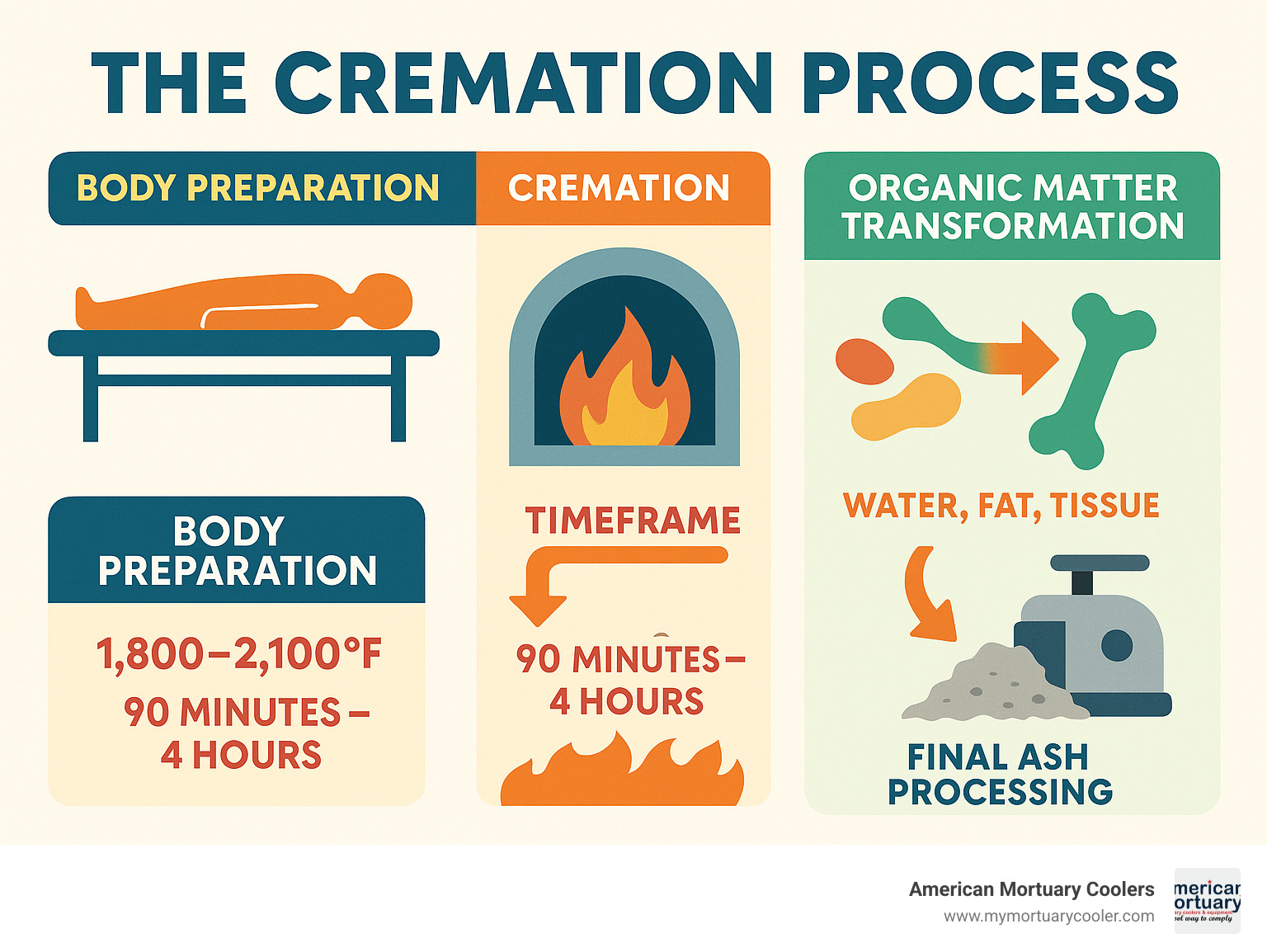
What Exactly Are Human Ashes?
When we talk about "human ashes," we're actually using a term that's not quite accurate. What families receive after cremation isn't really ash at all—it's pulverized bone fragments transformed by intense heat and careful processing.
During cremation, everything soft in the human body—water, fat, muscle, organs—disappears. What remains are the hard, mineral-rich bones that formed the person's skeleton. These bones are what human ashes actually are.
Cremation takes place in a specialized chamber called a retort, where temperatures reach 1,800 to 2,100 degrees Fahrenheit. This vaporizes organic material but leaves the calcium-rich bone structure intact. The process usually takes 90 minutes to 4 hours, depending on the person's size and the equipment.
After cooling for 30 to 60 minutes, the bone fragments pass through a magnetic field to remove any metal implants, dental fillings, or surgical hardware. Then, a cremulator grinds the fragments into the uniform, sand-like powder that families recognize as cremated remains.
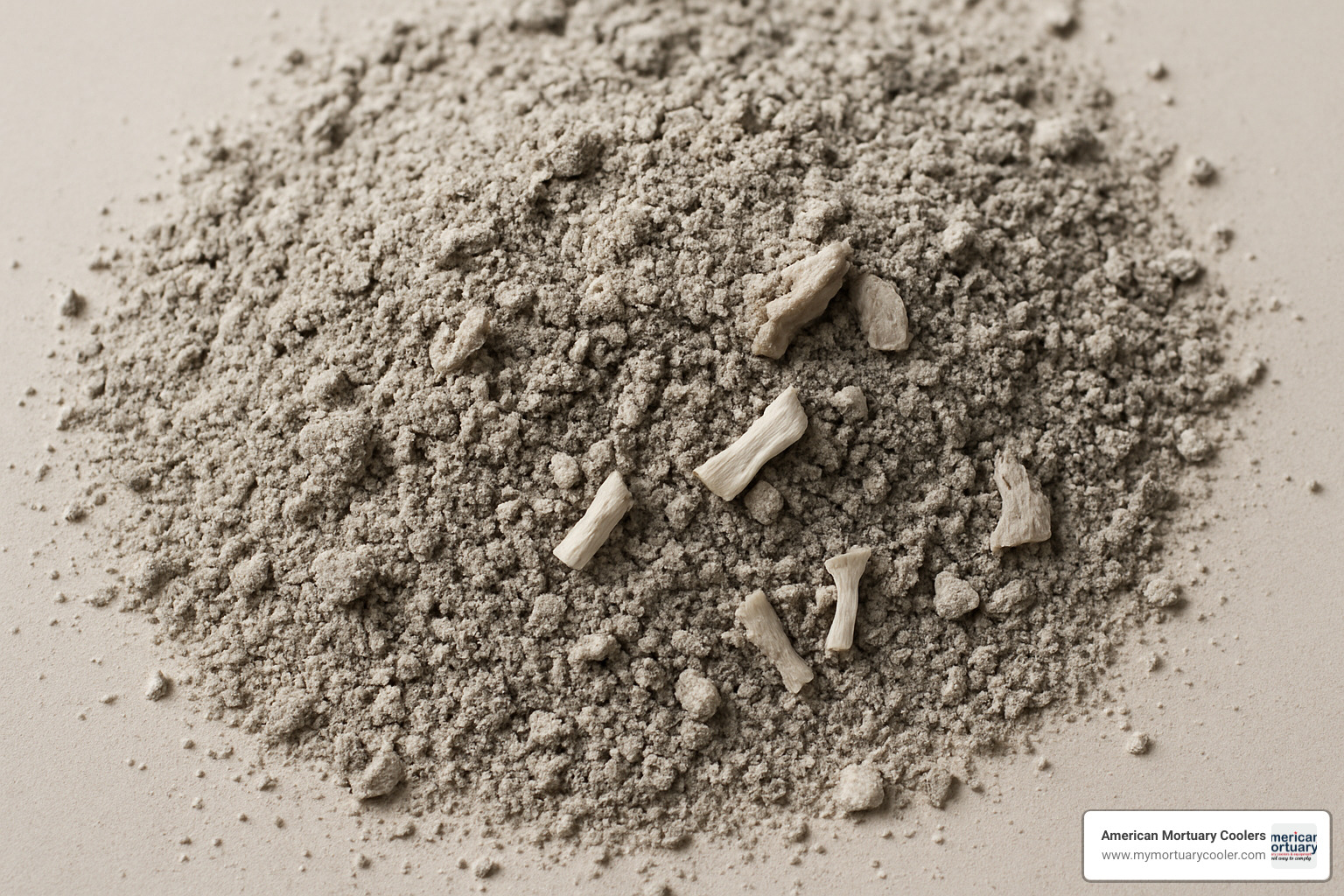
Human Ashes Composition & Appearance
The composition of human ashes is fairly consistent, though each set of remains has its own unique chemical signature. Most cremated remains are calcium phosphates (65-85%), which formed the structure of the person's bones. Calcium carbonates make up another 10-25%, and trace metals and salts—including potassium, sodium, and minerals absorbed over a lifetime—make up the rest.
Each person's ashes are individual: their trace element profile reflects where they lived and what they ate. For example, someone who lived near the ocean might have higher sodium levels. These tiny variations create an "elemental fingerprint"—a chemical record of a lifetime's worth of environmental exposure.
Despite expectations, human ashes look very similar regardless of physical characteristics. Hair color, skin tone, and other features don't affect the final appearance. All cremated remains share a pale to dark grey color and sand-like texture from the mineral composition of human bones.
The grey color comes from natural minerals in bone tissue. Some ashes may appear slightly whiter or darker depending on cremation temperature and bone density, but the overall appearance is consistent.
Human Ashes Weight & Volume
A common question is about the weight and volume of human ashes. There's a reliable formula: cremated remains typically weigh about 3.5% of the person's original body weight.
Adult males usually produce around 6 pounds of cremated remains, while adult females yield about 4 pounds. For children, the weight varies based on age and development.
Interestingly, height correlates more strongly with ash weight than overall body weight. A tall, thin person often produces more cremated remains than a shorter, heavier person because bone structure contributes more to the final weight than soft tissue.
Most adult cremated remains occupy about 200 cubic inches of space. This is important when selecting urns or dividing remains among family members.
The funeral industry uses a rule of thumb for urn sizing: allow 1 cubic inch of urn capacity for each pound of the person's body weight. Many families choose larger urns for aesthetic reasons or to ensure enough space.
Handling & Transporting Human Ashes Legally
Moving human ashes from one place to another can seem overwhelming, but once you know the basics, it's straightforward. The key is having the right paperwork and knowing what's allowed where you're going.
Think of it like traveling with any valuable item—you need proper identification and documentation. For human ashes, this means having a death certificate and certificate of cremation with you at all times. These documents prove who the remains belong to and verify they've been legally cremated. Depending on your plans, you might also need a permit for disposition.
Most transportation authorities understand families need to move cremated remains for memorial services, burials, or to bring loved ones home. They've created clear guidelines to make this process as smooth as possible.
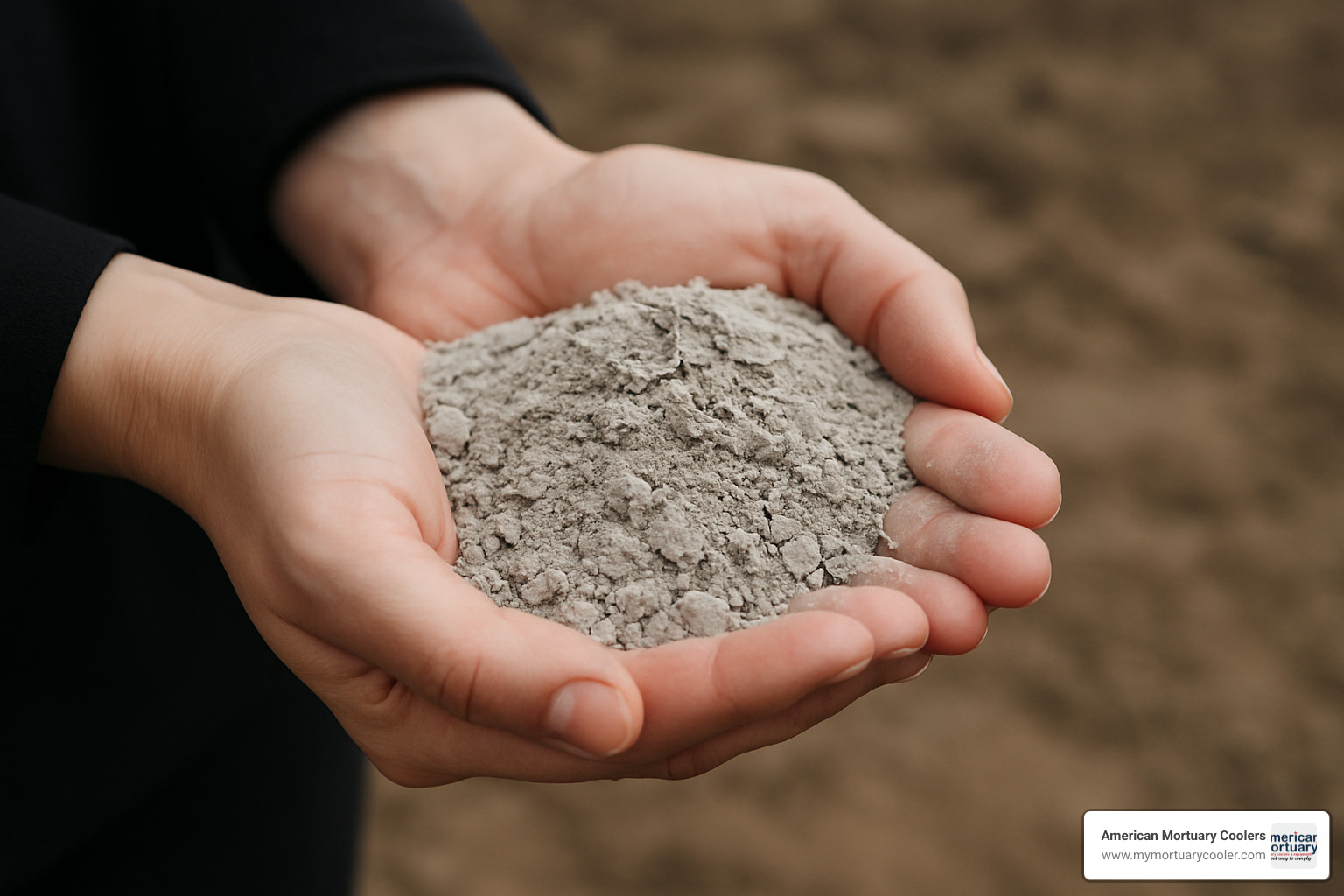
Choosing the right container is important when transporting ashes. For detailed guidance, see our guide on From Ashes to Boxes: Choosing the Right Cremation Container.
Domestic Travel with Human Ashes
Flying within the United States with human ashes is legal, but the TSA has specific rules. Cremated remains can go through security as carry-on baggage—this is usually the safest option.
To make TSA screening go smoothly, use a temporary container that X-rays can see through easily. Avoid metal urns during travel, even though they're beautiful for permanent display. Most funeral directors provide a simple cardboard or plastic container for travel.
The container must be sift-proof—no ashes can leak out during handling. TSA agents need to put the container through the X-ray machine separately, so make sure it's sealed properly.
When you check in, let the airline staff know you're carrying cremated remains. They're trained to handle this respectfully and can provide extra assistance if needed. Keep your death certificate and cremation certificate accessible, as you may need to show them during security.
TSA agents handle cremated remains regularly and treat them with dignity. The key is being prepared with the right container and documentation.
International & Mailing Requirements for Human Ashes
Taking human ashes across international borders requires more planning, and the rules change depending on your destination. Always contact the embassy or consulate of your destination country first.
Most countries will ask for translated death and cremation certificates, and some require special approval stamps or health department permits. These requirements exist to prevent illegal transport and ensure proper identification.
If you're mailing cremated remains, services like Canada Post allow this with proper packaging. The remains need to be in a sealed inner container, then placed in a sift-proof outer container with cushioning. Use a trackable parcel service and attach the certificate of cremation to the outside of the package.
For burial at sea in Canada, you'll need a Letter of Advice from Environment and Climate Change Canada (ECCC) under the Canadian Environmental Protection Act (CEPA).
International rules can seem complicated, but customs officials and postal workers deal with these situations regularly. With the proper documentation, most are helpful and understanding.
Memorialization Traditions & Innovations
The world of human ashes memorialization has transformed dramatically in recent decades. While traditional urns and burial plots remain meaningful choices for many families, creative alternatives now offer deeply personal ways to honor loved ones that would have been impossible just a generation ago.
What makes today's options so compelling is how they can reflect the unique personality, interests, and dreams of the person being remembered. A music lover might become a playable vinyl record, while someone who always wanted to see the stars could take their final journey to space. These aren't just novel ideas - they're genuine expressions of love and remembrance.
For families exploring traditional options, our comprehensive guide The Complete Guide to Choosing Cremation Urns covers everything you need to know about classic memorial choices.
The range of creative possibilities continues to expand as technology and artistry meet grief and celebration. Memorial diamonds created from carbon in cremated remains offer a tangible connection that can be passed down through generations. Firework displays through companies like Heavenly Stars Fireworks transform a somber goodbye into a celebration of life that lights up the sky.
Other meaningful innovations include vinyl records pressed with ashes and favorite songs, glass art that captures light and memory in beautiful sculptures, and memorial reefs that support marine life while honoring the deceased. For those drawn to nature, tree planting using ashes as fertilizer creates living memorials that grow and flourish over time.
More unique options include tattoo ink mixed with small amounts of ashes for memorial tattoos, space launches via balloon or rocket, memorial paintings that incorporate ashes into the paint, and even ceremonial ammunition for military families who want to honor their loved one's service.
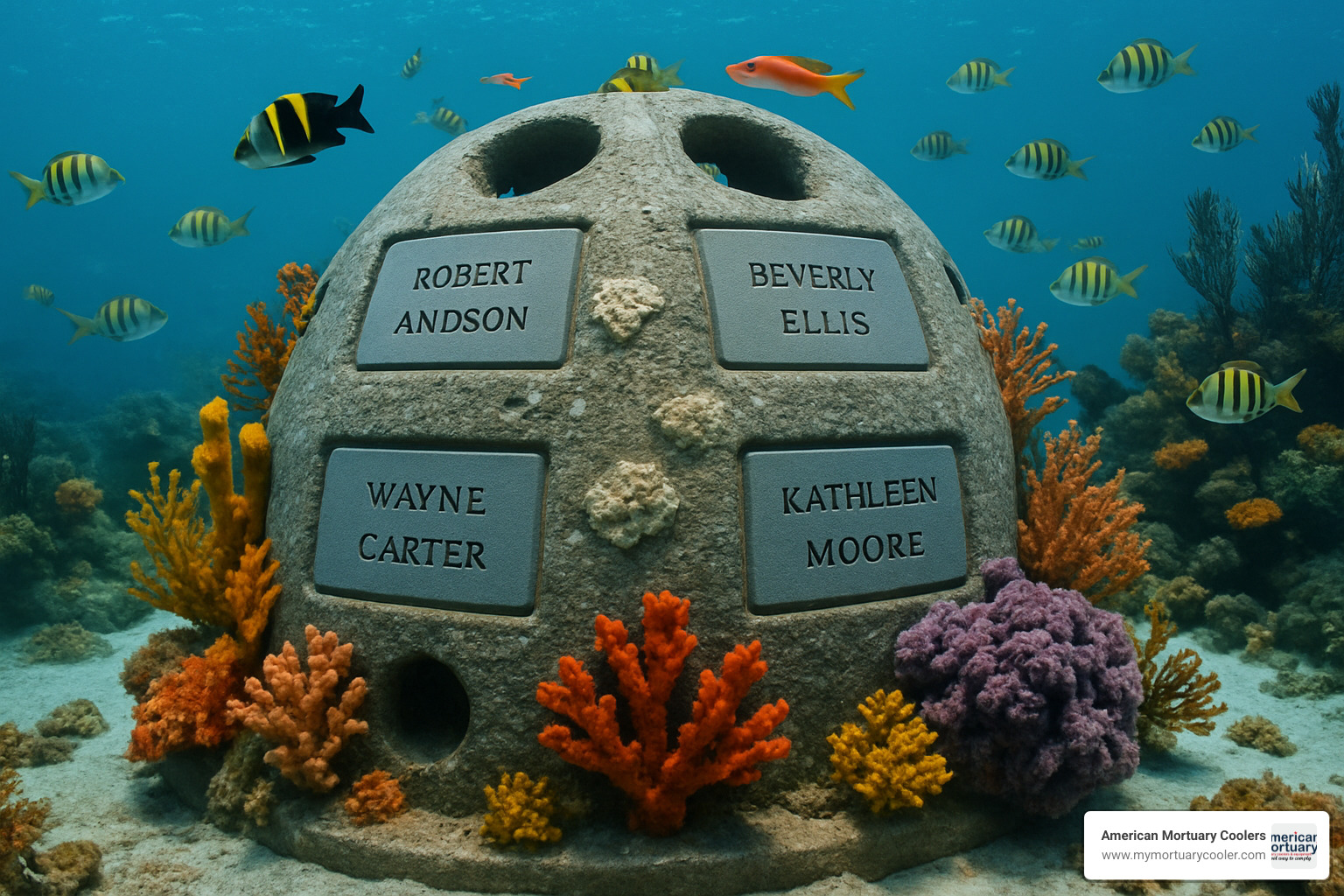
Classic Ways to Keep Human Ashes
Traditional approaches to memorializing human ashes have endured because they provide comfort, dignity, and permanence that many families find essential during their grief journey. These time-honored practices offer familiar ways to honor loved ones while ensuring their memory remains accessible for future generations.
Display urns continue to be the most popular choice, allowing families to keep their loved one close in their daily lives. Today's urns come in an incredible variety of materials and styles - from neat marble and warm wood to contemporary ceramic and eco-friendly bamboo. The key is finding something that feels right for your family, whether that's a simple, understated design or an ornate piece that makes a statement about the person it honors.
Columbarium niches provide a middle ground between home display and ground burial. These specialized buildings feature individual compartments for urns, often with beautiful memorial plaques and peaceful garden settings. Many families appreciate having a dedicated place to visit that's maintained by professionals and offers a sense of community with other grieving families.
Cemetery burial plots for urns require much less space than traditional casket graves but provide the same sense of permanence and tradition. Many modern cemeteries have created dedicated cremation gardens with specialized landscaping, memorial walls, and quiet spaces for reflection.
Urn vaults protect buried urns from ground pressure, moisture, and other environmental factors that could damage the container over time. These protective chambers ensure that human ashes remain secure and undisturbed. For detailed information about how these systems work and why they matter, see our guide Urn Vaults Uncovered: Ensuring a Secure Burial.
Cutting-Edge & Personal Options for Human Ashes
Innovation in memorial services has opened up extraordinary possibilities for honoring human ashes in ways that truly capture the essence of who someone was in life. These cutting-edge options often appeal to families who want something unique, meaningful, and deeply personal.
Memorial diamonds represent perhaps the most remarkable advancement in ash memorialization. Using High Pressure High Temperature technology, companies extract carbon from cremated remains and compress it into genuine diamonds over several months. These aren't synthetic stones - they're real diamonds with the same structure and brilliance as mined gems. Families can choose from various colors including yellow, blue, pink, and colorless, creating a lasting tribute that can be worn, displayed, or passed down through generations.
Space memorial services fulfill the ultimate dream for those who always looked to the stars. Companies like Celestis offer multiple options, from suborbital flights that return to Earth after experiencing weightlessness, to deep space missions that travel indefinitely through the cosmos. Families can attend launch events and even track their loved one's journey through space using online tools. While prices start around $2,495 for Earth orbit missions, many families find the experience provides closure and celebration that traditional memorials can't match.
Glass art infusion creates stunning keepsakes by incorporating small amounts of ashes into blown glass sculptures, jewelry, or decorative objects. Master glass artists heat the material to over 2,000°F and carefully blend in the ashes, creating swirled patterns that catch and reflect light in ways that seem almost alive. Each piece is completely unique, just like the person it honors.
Vinyl records offer a deeply personal memorial for music lovers, with ashes actually pressed into playable records alongside chosen songs or recorded messages. Ash tattoos allow family members to carry their loved one with them always, using specially prepared ink that contains small amounts of cremated remains.
For families interested in creating multiple smaller keepsakes to share among relatives, our guide Tiny Tributes: Keepsake Urns for Lasting Memories explores beautiful options for dividing and displaying portions of human ashes in meaningful ways.
Skydiving releases and space balloon launches offer dramatic send-offs that celebrate adventurous spirits, while memorial services can incorporate ashes into fireworks displays that light up the sky in celebration of a life well-lived.
Environmental Considerations & Green Alternatives
The funeral industry is experiencing a green revolution, and families are increasingly asking about environmentally conscious options for human ashes. While cremation already has a smaller environmental footprint than traditional burial, there's still room for improvement and innovation in how we honor our loved ones while protecting the planet.
Traditional flame cremation isn't exactly carbon-neutral. Each cremation process generates roughly 240 kg of CO₂ emissions - about the same as driving a car for 600 miles. The high temperatures required to reduce a body to ashes consume significant amounts of natural gas, and older crematory equipment may lack modern emission controls. But here's the encouraging news: the industry is rapidly developing cleaner alternatives and more sustainable practices.
Alkaline hydrolysis represents the cutting edge of green cremation technology. This water-based process, sometimes called "aquamation" or "bio-cremation," uses heated water and potassium hydroxide to gently break down the body over several hours. The result? About 20% more human ashes than flame cremation, but with 75% fewer carbon emissions. While not yet legal in all states, alkaline hydrolysis is gaining acceptance as families seek gentler, more environmentally responsible options.
The real environmental innovation often comes after cremation, in how families choose to memorialize their loved ones. Modern biodegradable urns are changing the way we think about returning ashes to nature. These remarkable containers dissolve completely in soil or water, leaving no trace except the nourishing minerals from the ashes themselves.
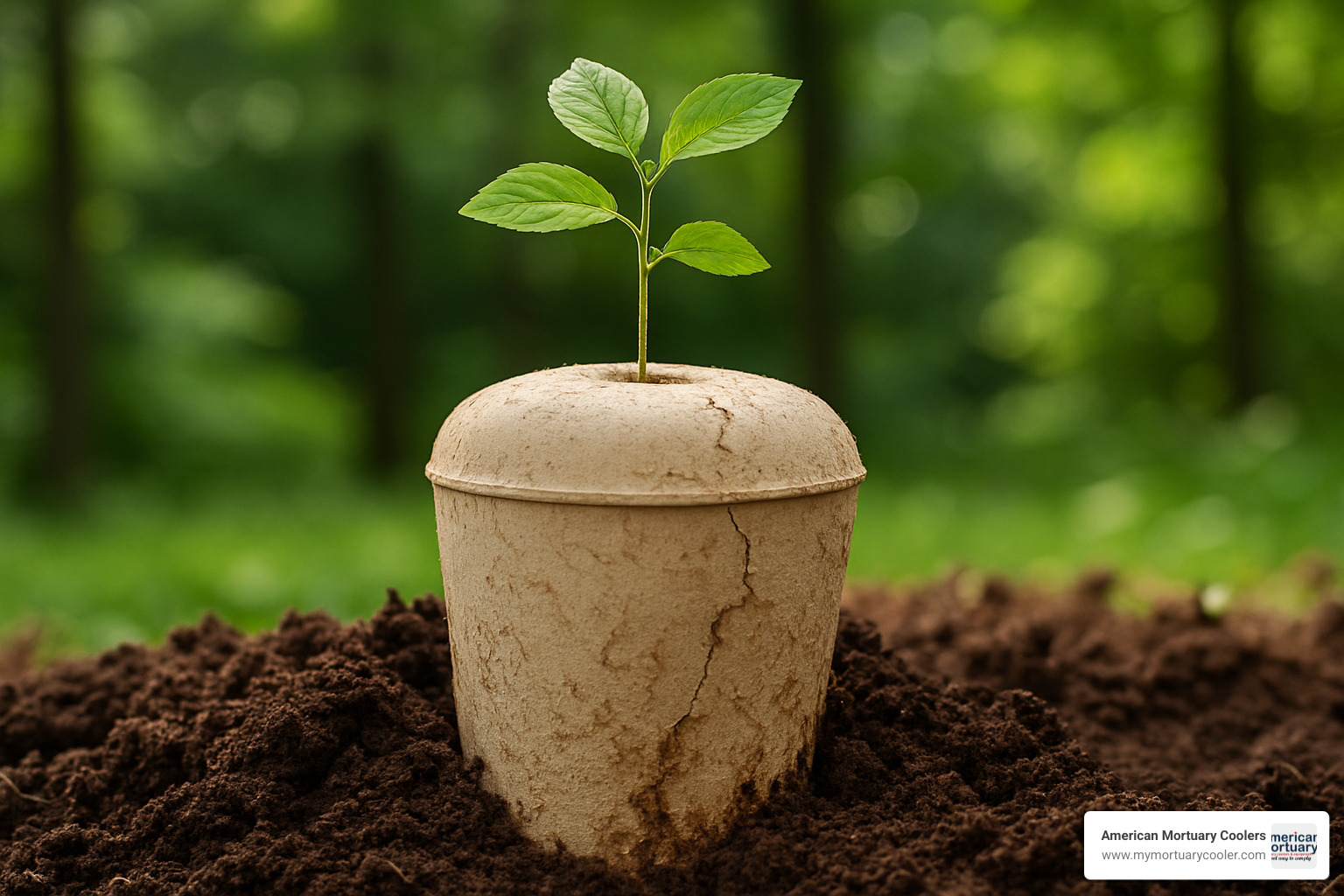
Tree pod burials capture many families' imagination as the ultimate green memorial. These biodegradable containers hold cremated remains along with tree seeds or saplings, creating living memorials that actively combat climate change. The calcium and phosphorus in human ashes provide excellent nutrients for growing trees, though the high pH means they work best when mixed with soil or compost.
Woodland burial grounds are popping up across the country, offering natural settings where families can inter biodegradable urns without traditional headstones or manicured landscaping. These conservation burial grounds protect native ecosystems while providing peaceful places for remembrance and reflection.
Marine memorials offer another compelling green option. Organizations like Solace Reef incorporate cremated remains into specially designed concrete reef balls that support underwater ecosystems. These artificial reefs provide habitat for fish, coral, and other marine life while creating permanent memorials beneath the waves. The concrete neutralizes the alkaline pH of ashes, making them safe for marine environments.
Even traditional crematory operations are becoming more environmentally conscious. Modern crematoriums install sophisticated filtration systems that capture mercury emissions from dental fillings and reduce particulate matter. Some facilities are experimenting with renewable energy sources and heat recovery systems that capture waste heat for other uses.
For families interested in exploring all their eco-friendly options, our comprehensive guide Ashes to Earth: The Complete Guide to Biodegradable Urns covers everything from materials and decomposition rates to specific products and pricing.
The beautiful thing about green memorial options is that they often cost less than traditional alternatives while creating positive environmental impact. Whether it's a tree growing from a loved one's ashes or a coral reef thriving around their memorial, these choices transform grief into growth and memory into living legacy.
Frequently Asked Questions about Human Ashes
When families first encounter human ashes, questions naturally arise about their composition, safety, and what can be done with them. As professionals who work daily with funeral directors handling cremated remains, we've heard these questions countless times. Let's address the most common concerns with straightforward answers.
What do human ashes consist of?
Human ashes are made up entirely of mineral bone fragments - nothing more, nothing less. The primary components are calcium phosphates and carbonates, the same minerals that give our bones their strength throughout life. What many people find surprising is that there's no DNA, no organic material, and absolutely nothing that could pose health risks.
The cremation process is incredibly thorough. Those intense temperatures between 1,800-2,100°F don't just reduce the body - they completely vaporize every trace of organic material. Water evaporates, soft tissues disappear, and even the organic matrix within bones breaks down completely. What remains is purely the mineral skeleton that supported us in life.
This means human ashes are completely sterile and safe to handle. There's no risk of disease transmission or contamination from properly cremated remains. We still recommend washing your hands after direct contact, but that's simply good hygiene practice, not a safety requirement.
How can I divide human ashes among family members safely?
Sharing human ashes among family members is one of the most common requests we see, and it's absolutely something that can be done safely and respectfully. The key is proper planning and the right approach to handling this meaningful task.
The most important consideration is using appropriate containers. Keepsake urns designed for sharing typically hold anywhere from 1 to 10 cubic inches of ashes, allowing multiple family members to have meaningful portions while preserving the majority for primary disposition. These smaller containers come in the same beautiful materials and styles as full-sized urns.
When it comes to the actual division, working in a clean, calm environment makes all the difference. Choose a space away from wind or drafts, and have all your containers ready beforehand. A simple funnel or small scoop helps transfer the ashes carefully and respectfully. Label each container clearly with your loved one's name and dates, and keep detailed records of who received which portion.
Many funeral homes offer this service professionally, which can take the stress off families during an already difficult time. They have the experience and proper tools to ensure dignified handling and complete documentation. For more guidance on selecting appropriate containers for different family members, see our guide on Tiny Tributes: Keepsake Urns for Lasting Memories.
Where am I allowed to scatter human ashes?
The rules around scattering human ashes can be surprisingly complex, varying dramatically depending on where you are and where you want to scatter. While the practice is widely accepted, understanding local laws and getting necessary permissions protects you from legal complications and ensures your ceremony goes smoothly.
Private property offers the most straightforward option - as long as you have the landowner's permission, you're generally free to scatter ashes respectfully. This includes your own property, family land, or anywhere the owner has given consent. Many families find this the most meaningful option since it often connects to places their loved one enjoyed in life.
Ocean scattering is permitted in most coastal areas, but typically requires being at least 3 nautical miles from shore and following environmental guidelines. The good news is that most jurisdictions don't require special licenses for sea scattering, though it's always wise to check local maritime regulations.
Public lands present more complexity. Some national and state parks allow scattering in designated areas, while others prohibit it entirely. Designated scattering gardens in cemeteries provide a middle ground - these specially designed spaces welcome ash scattering while maintaining the dignity and regulations families expect.
Rivers and inland waterways often have their own specific rules, and urban areas typically restrict or prohibit scattering due to public health and respect considerations. When planning any scattering ceremony, the safest approach is checking with local authorities, park services, or maritime agencies beforehand.
If you're feeling overwhelmed by the regulations, don't hesitate to consult with funeral professionals who understand regional requirements. They can help you steer the legal landscape while planning a meaningful ceremony that honors your loved one appropriately.
Conclusion & Next Steps
Understanding human ashes gives families the knowledge they need to make thoughtful decisions during one of life's most challenging times. From learning that these remains are actually mineral bone fragments to finding innovative memorial options like space launches and living reefs, this journey through cremation can help transform grief into meaningful remembrance.
The world of memorial services continues evolving as cremation rates climb past 70% in many regions. What started with simple urns has blossomed into countless ways to honor our loved ones - whether through traditional columbarium niches, eco-friendly biodegradable urns, or cutting-edge memorial diamonds. Each option offers families a chance to create tributes as unique as the people they're remembering.
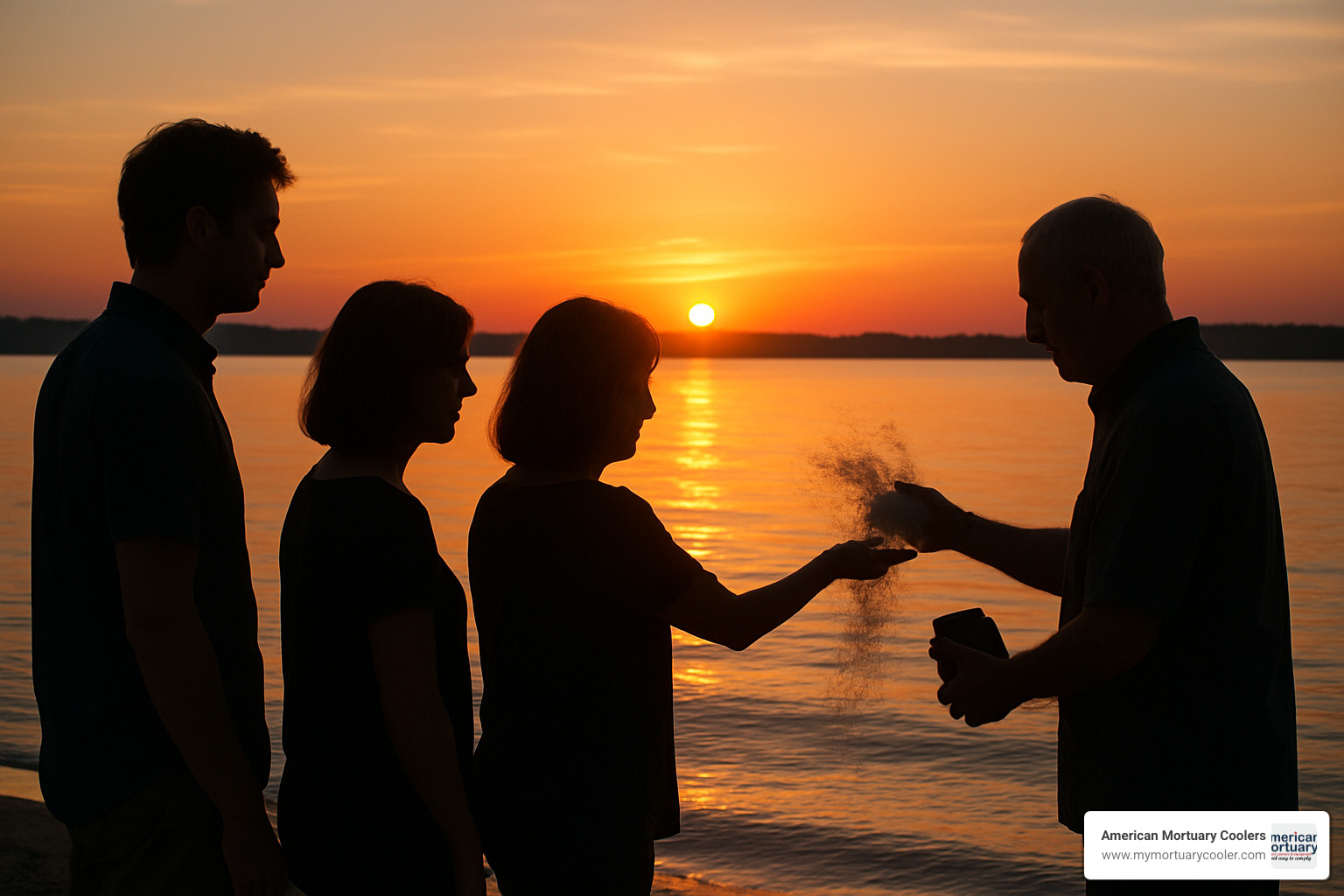
Planning ahead makes all the difference. Family conversations about preferences help avoid difficult decisions during emotional times, while researching local regulations prevents last-minute complications with scattering or burial plans. Many families find comfort in keeping small portions of ashes in keepsake urns, allowing for multiple memorial options or giving relatives meaningful mementos.
Proper documentation remains crucial whether you're traveling with cremated remains or planning international scattering ceremonies. The death certificate and cremation certificate become your most important companions, opening doors for everything from airline travel to cemetery arrangements.
Environmental considerations are becoming increasingly important to families who want their final acts to support the planet. From alkaline hydrolysis to memorial tree plantings, green alternatives offer meaningful ways to return human ashes to the earth while supporting natural ecosystems.
For families exploring unique memorial possibilities, our guide Memories in Style: Unique Cremation Keepsakes and Urns offers additional inspiration for creating lasting tributes.
At American Mortuary Coolers, we understand that every family's journey is different. That's why we're committed to supporting funeral professionals across the country - from the mountains of Tennessee to the beaches of California - with dependable mortuary equipment that maintains dignity throughout the cremation process. Our custom coolers and specialized equipment help ensure that every step meets the respectful standards families deserve.
Whether you're a funeral director seeking reliable equipment or a family planning for the future, understanding this journey from "ashes to ashes" helps ensure every decision honors your loved one's memory with the care and respect they deserve.
















